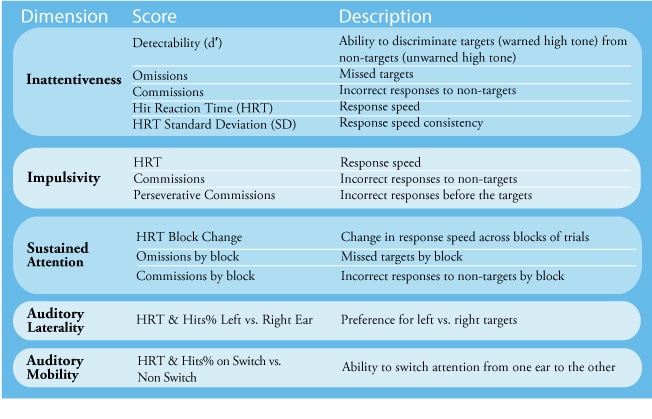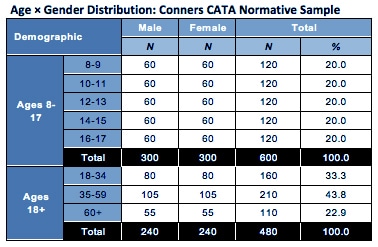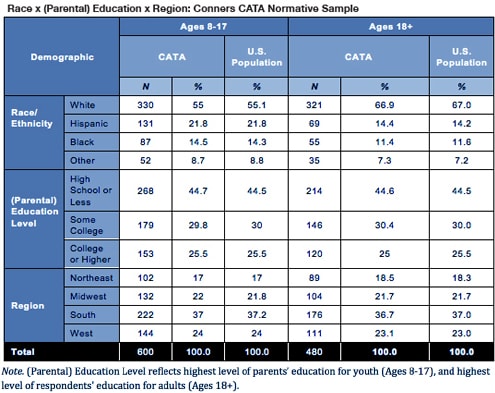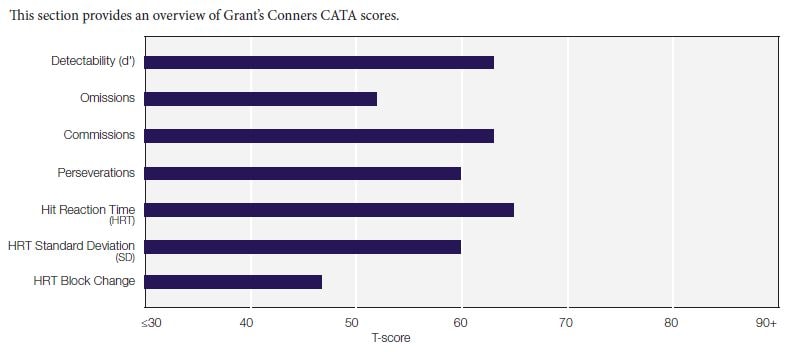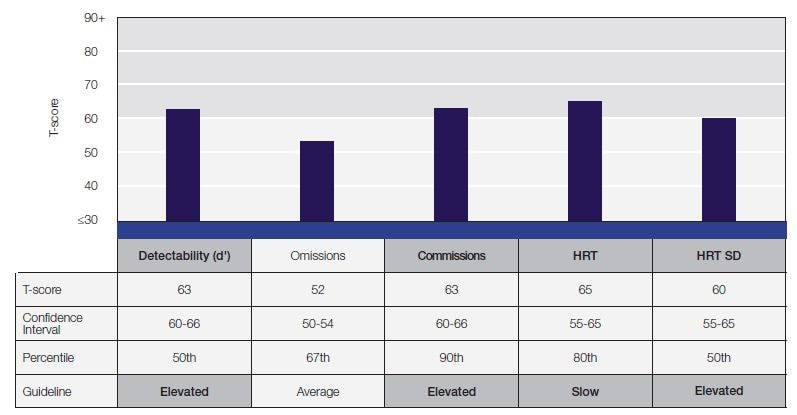Conners Continuous Auditory Test of Attention
Conners CATA- Conners CATA assesses auditory processing and attention-related problems in individuals aged 8 years and older.
- PCTA distributes but does not publish this product.
Choose from our formats
-
Kits
Starter & complete kits, print & digital
1 option
From AUD 3,718.44
-
Conners CATA & CPT Combo Unlimited Kit
9781925120387 Qualification Level BIncludes:
- Manual
- CATA & CPT 3 Unlimited-Use Combo Software
Software requires Windows XP, 7, or 8 and USB port.
Not compatible with Mac OS.
Software can be installed on multiple computers but will only run when USB is plugged in.
Overview
- Publication date:
- 2014
- Completion time:
- 14 minutes
- Administration:
- Individual; PC software administration
- Age range:
- 8 years and over
- Qualification level:
- B
Product Details
|
The Conners Continuous Auditory Test of Attention™ (Conners CATA™) assesses auditory processing and attention-related problems in individuals aged 8 years and older. By indexing the respondent’s performance in areas of inattentiveness, impulsivity, and sustained attention, the Conners CATA can be used to evaluate attention disorders and neurological functioning. The Conners CATA provides objective information about an individual’s performance in attention tasks, complementing information obtained from rating scales such as the Conners 3. The Conners CATA can be used in conjunction with the Conners Continuous Performance Test 3rd Edition™ (Conners CPT 3™) which is a task-oriented computerized assessment of attention-related problems in individuals aged 8 years and older. The Conners CATA and Conners CPT 3 can be purchased as a combo kit or individually. Click here to learn more about the Conners CPT 3.
Quick Review of the Conners CATA:
How to Use the AssessmentDuring the 14-minute, 200-trial administration, respondents are presented with high-tone sounds that are either preceded by a low-tone warning sound (warned trials) or played alone (unwarned trials). Respondents are instructed to respond only to high-tone sounds on warned trials, and to ignore those on unwarned trials. On most trials, the low-tone and the high-tone sounds are played in the same ear (non-switch trials). On switch trials, the low-tone warning sound and the high-tone target sound are played in different ears, requiring the respondent to shift auditory attention from one ear to the other. The Conners CATA is available as an unlimited use program. The number of computers that can use the program is limited to the number of installations purchased. Scoring and Interpretation
|
The Most Representative CPT Normative Samples CollectedThe normative sample consists of 1,080 cases and is representative of the United States (U.S.) population in terms of key demographic variables such as gender, race, geographical region, and parental education level. ReliabilityUsers can be confident that the Conners CATA will yield consistent and stable scores across administrations. Internal ConsistencyOne measure of a test’s internal consistency is split-half reliability, which has been previously used to establish the reliability of other continuous performance tests. Split-half reliability estimates of the Conners CATA scales were calculated for the normative and clinical samples. Results were very strong – across all scores, the median split-half reliability estimate was .95 for the norm and clinical samples (all correlations were significant, p < .001). These results indicate that the Conners CATA demonstrates excellent internal consistency for both the normative and the clinical groups. Test-Retest ReliabilityTest-retest reliability refers to the consistency of scores obtained from the same respondent on separate occasions over a specified period of time. To estimate the test-retest reliability of the Conners CATA, a sample of 69 respondents from the general population completed the Conners CATA twice with a 1- to 4-week interval between administrations. The median test-retest correlation was .64. These results suggest a good level of test-retest reliability. ValidityUsers can be assured that the Conners CATA will help detect attention deficits and differentiate Clinical from Non-Clinical Cases. Discriminative ValidityDiscriminative validity pertains to an instrument’s ability to distinguish between relevant participant groups (i.e., the test’s ability to differentiate between clinical and non-clinical groups). In order to conduct discriminative validity analyses, Conners CATA data were collected during the standardization process from 193 children and adults who had an existing ADHD diagnosis. Conners CATA scores from this ADHD sample were compared to a matched sample from the general population. Results indicated that differences were found between the ADHD sample and the matched general population sample on most measures with small to moderate effect sizes (d = 0.10 to 0.63). As expected, the ADHD sample demonstrated poorer performance (i.e., they had higher scores on the Conners CATA). In particular, the ADHD sample had lower d′ scores, indicating that they had more difficulty in distinguishing between target trials and non-target trials than did the general population sample. Similarly, the ADHD sample made a greater number of errors (i.e., they had higher percentages Commissions and Perseverative Commissions than did the general population sample) and showed more variability in their responses (i.e., higher HRT SD scores, when compared to the matched general population sample). Incremental ValidityAnother approach in establishing the Conners CATA’s validity is to show how it works together with other measures of similar constructs in the assessment of attention problems. To assess such validity, samples were collected in which cases were scored on the Conners CATA and other measures of attention. Specifically, in a sample of 112 youth, parent-reports on the Conners 3rd Edition (Conners 3-P) were collected in addition to their scores on the Conners CATA and the Conners CPT 3. Logistic regressions were conducted in order to determine how well scales from the Conners CATA improve the diagnostic efficacy of the Conners 3-P and Conners CPT 3 in predicting group membership into ADHD or general population groups. Results are presented in the table below. When the Conners 3-P, Conners CPT 3, and Conners CATA scores were considered together, there was an overall correct classification rate (i.e., the ability to accurately predict group membership) of 93.8%, sensitivity (i.e., the ability to correctly detect ADHD cases) of 94.7%, and specificity (i.e., the ability to correctly detect general population cases) of 92.7%. These values were 9.9%, 8.7%, and 10.9%, respectively, higher than when the rating scale was used on its own. Furthermore, the Conners CATA added increased classification accuracy over and above the Conners 3-P and Conners CPT 3. Easy to Read Reports:The computer-generated scoring reports have been designed to guide assessors through each step of the recommended interpretation process.
There are two report types available:
The system requirements are:
Common Question:Q: Can I use the Conners CPT 3 and the Conners CATA on an Apple computer running OS X? A: No, the software will not work unless the computer is running Windows as its operating system. System Requirements
This product is not compatible with MAC. |


